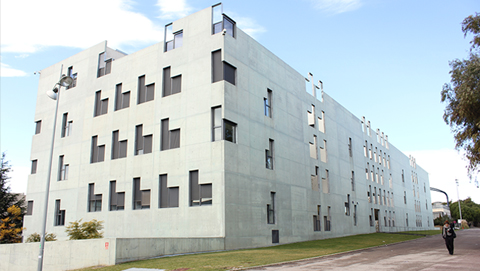Possible ICN2 and ICMAB research laboratory on ice and snow formation at the SnowWorld complex

The ICN2 and ICMAB-CSIC, both located at the UAB campus, have signed a cooperation agreement with the Dutch company SnowWorld to locate a laboratory within the artificial ski slope the company aims to construct at the Zona Franca area of Barcelona.
12/12/2014
SnowWorld wants to build an energetically sustainable winter sports resort at the Zona Franca area of Barcelona.
The Dutch company's project, to be funded by private capital and still pending approval by the authorities of the city, obtains a new scientific dimension with the signing of a cooperation agreement with the Institut Català de Nanociència i Nanotecnologia (ICN2), a foundation formed by CSIC, Generalitat de Catalunya and Universitat Autònoma de Barcelona (UAB), belonging to the Catalan Government's CERCA network, and the Institut de Ciencia de Materials de Barcelona (ICMAB-CSIC), both located at the UAB campus in Bellaterra. Thus, two public scientific institutions would benefit from this initiative.
The natural process of rain and snow formation usually starts from the freezing of the droplets that form clouds.
These droplets reach the surface of the planet as snow or water depending on the environmental temperature. If clouds were formed exclusively of water, they would require temperatures of about -40o C to freeze drops of pure water. Clouds, despite being at temperatures below zero for their localisation in the higher strata of the atmosphere, are far from reaching these temperatures. The droplets' freezing process is possible at higher temperatures due to the particles mixed with the water, such as desert sand, sea salt, pollen or pollution.
The research led by Dr. Albert Verdaguer, CSIC researcher at the ICN2, aims among other challenges to find a better way to control the freezing of the water with a snow producing aim. There is a need for a better understanding of the role of these particles and which materials are most effective in reproducing the natural process in the ski slopes. This is possible by studying the particles in the atmosphere, a fact that will help understand the rainfall distribution and how pollution and climate change affect to this natural process. Through nanotechnology and materials science it is possible to design new nanostructures to make this process as efficient as possible.
Controlling these mechanisms would produce snow at temperatures closer to 0 oC, with less water, less energy, and thus more similar to the natural process and choosing the type of snow that is generated for each application.
It must be noted however that the knowledge gained by this research goes beyond the applications it might have for the SnowWorld resort. It might help to understand processes related to climate change or could have important implications for the food industry, where the ice is continuously used in product preservation. Moreover, it may be used to prevent water from freezing, protecting machinery in open air, preventing the accumulation of ice on aircrafts or helping conservation of biological samples.
The research carried out in the laboratory is done in small amounts and under controlled conditions. Having a research area integrated on the resort that SnowWorld intends to build in the city of Barcelona would make the results obtained in the laboratory become a reality. An indoor ski slope would ensure easy access during all seasons of the year to temperatures and environmental conditions which would facilitate the work of researchers.